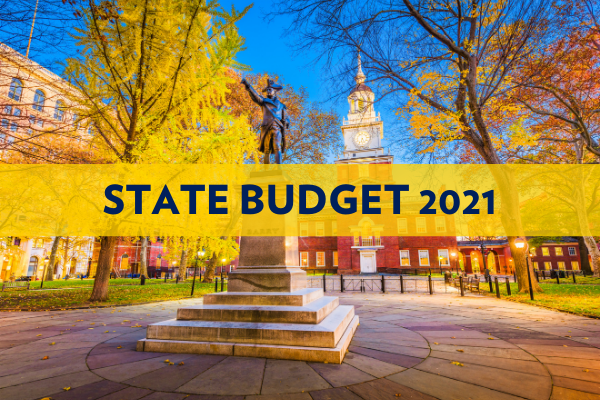Fact Sheet

2021 Budget Takeaways
Last week, the Pa. General Assembly passed a state budget deal that includes $40 billion in the General Fund budget, increases in tax credit scholarships, and a number of policy changes and related legislation.
Here are five takeaways about the deal that taxpayers and families should know.
1) The spending increase greatly exceeds inflation and population growth.
- The new budget includes total ongoing general fund spending of $39.78 billion, an increase of 8.8% over last year’s enacted budget.
- Counting one-time expenses from federal stimulus funds, the total spending is $40.8 billion.
- This increase of $3.2 billion significantly exceeds the increase under the Taxpayer Protection Act index of $654 million (1.79%).
- The spending increase for the Department of Human Services is $1.8 billion (11.7%)—including both ongoing and one-time costs.
- This increase is on top of Gov. Wolf’s $850 million in cost overruns in 2020–21, which the Legislature is prepared to authorize as supplemental appropriations.
- Education (support of public schools) will see an increase of $660 million, or 5%, on top of already-record-high state spending.
- Of this, $300 million is for basic education, $50 million for special education, $20 million for the Ready to Learn Block Grant, $30 million for pre-K and Head Start, and $54 million for school transportation.
- This increase is on top of the billions of dollars school districts continue to receive from federal pandemic programs
2) The budget deal expands the number of educational opportunity scholarships, but waiting lists will remain.
- The $40 million increase in tax credit scholarships is the second-largest one-year increase, translating into about 13,000 additional scholarships.
- It still falls short of the need, however, as 43,000 students are currently denied EITC and OSTC scholarships because of program limits.
- This increase is not enough to eliminate the waiting list—leaving tens of thousands of low-income students out in the cold, waiting for scholarships that are a fraction of the cost of public-school spending.
- The increase pales in comparison to the increase in public-school funding—even while enrollment in school districts has declined.
- Charter schools, which also have waiting lists and receive less funding per student than school districts, but have seen enrollment increase, are left out of the budget deal entirely.
3) Despite stories of a surplus, the outlook isn’t so rosy.
- Thankfully, the budget plans for future years by depositing $2.5 billion of state funds into the Rainy Day Fund and preserving most of the temporary federal funds for future use.
- The plan continues to use one-time federal revenues to balance the budget. Specifically, $1.2 billion of state Medicaid costs are covered by temporary FMAP matching funds—revenues that will have to be replaced by state sources beginning next year.
- Revenue is expected to decline next year. The Independent Fiscal Office projects general fund revenue will be $2 billion less in 2021–22 than the current year’s revenue.
4) The long-term fiscal imbalance remains.
- The Independent Fiscal Office projects annual deficits exceeding $2 billion in future years.
- This deficit could require future tax hikes or spending cuts to address it. The current budget doesn’t do enough to control costs—particularly the escalating costs in Human Services.
- Medicaid enrollment is at an all-time high, a 42% increase in enrollment since 2010, now covering more than a quarter of all Pennsylvanians. Enrollment continues to rise even as the pandemic wanes. While the budget deal’s guardrails around new assistance programs are helpful, the driver of Medicaid’s explosion are the pandemic’s limits on verifying eligibility.
5) The budget deal eliminates harmful, job-killing mandates but falls short of promoting growth.
- The budget deal rescinds Gov. Wolf’s unilateral overtime rule. This regulation would have driven up costs for employers, consequently resulting in fewer jobs.
- While the deal prevents one job-killing regulation, however, it doesn’t do enough to help create jobs and win the race to rebuild.
- The budget deal doesn’t provide for hiring incentives (and keeps in place unemployment bonuses that other states have ended), doesn’t provide small business tax relief, doesn’t provide regulatory reform, and doesn’t include liability protections.